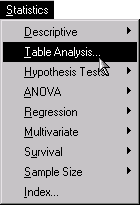| Table Analysis |
Introduction
Often you need to analyze the information in a table, sometimes called a contingency table or a crossclassification table. You may analyze a single table, or you may analyze a set of tables. You are also often concerned with evaluating the presence of association in a table, or whether there is some sort of relationship between the variable determining the rows of the table and the variable determining the columns of the table. If there is an inherent ordering in the rows or columns of the table, the association may be linear. Various chi-square statistics such as the Pearson chi-square and the likelihood ratio chi-square are used to assess association.
 |
Figure 9.1: Table Analysis Selection Menu
Besides assessing the presence of association, you may also be interested in computing a measure of association, or a statistic that provides some understanding of the strength of the association. The odds ratio is a standard measure of association often used in medical and epidemiological studies.
Using the Table Analysis task, not only can you analyze a single table, but you can also analyze sets of tables. This provides a way to control, or adjust for, a covariate, while assessing association of the rows and columns of the tables. Extended Mantel-Haenszel statistics, also called Cochran-Mantel-Haenszel statistics, provide a way to utilize all the information in the constituent tables in a test for the hypothesis of association. Tables may also contain information from observer agreement studies in which the evaluations or assessments of two different observers are collected. Statistics called measures of agreement assess how closely the observers agree.
The Table Analysis task provides chi-square tests of association for the r×c table, including statistics such as the Pearson chi-square and likelihood ratio test, and it also computes extended Mantel-Haenszel tests for sets of tables. Fisher's exact test can be computed for both the 2 × 2 and r × c table. In addition, the Table Analysis task also provides measures of association such as the odds ratio and relative risk for the 2 × 2 table as well as gamma, tau-b, Somer's D, and the Pearson and Spearman correlation coefficients. In addition, you can obtain measures of agreement such as the kappa coefficient and the weighted kappa coefficient. McNemar's test is produced for the 2 × 2 table.
The examples in this chapter demonstrate how you can use the Analyst Application to analyze tables, including assessing the presence of association in a table and sets of tables and assessing observer agreement.
Copyright © 2007 by SAS Institute Inc., Cary, NC, USA. All rights reserved.